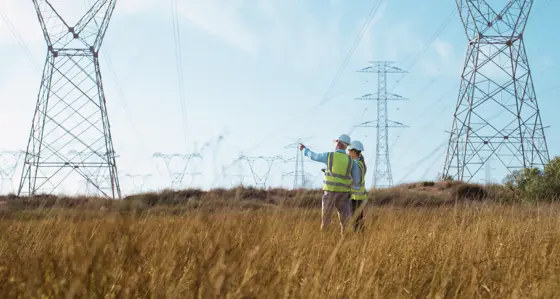
How can digital and data sharing help deliver the energy transition?
6 min read 12 June 2024
In the drive to decarbonise the energy system, renewables and distributed energy resources (DERs) are being deployed at an unprecedented pace – and it’s changing the face of the energy system as we know it. Soon, the energy grid will include millions of distributed assets enabling flexible energy generation, consumption and storage – electric vehicles, heat pumps, solar photovoltaic panels, grid-scale storage and more.
It will take an extraordinary level of data availability and analysis to support installation, connection and operation of these assets in the most economical way. They will also need to be highly visible and seamlessly coordinated to deliver optimal yield and stable operation. Participants will need to capture, share and build on data about the grid and its components to drive informed decisions on everything from asset choice and installation to pricing and delivering services.
That’s where the principle of “Open Energy” comes into play. Open Energy is a system that will allow multiple parties to access and share consumer and asset data from other parties through the use of APIs.
How will this work?
Just as open banking has opened the doors to greater collaboration and data sharing in the financial services industry, the concept of ‘Open Energy’ holds the promise of guiding utilities on a similar path. Improved data exchange and interoperability will enable new assets to be rapidly and more effectively integrated into the energy system.
The “common data sharing infrastructure” is a continuation of the existing ‘digital spine’ concept, defined by the Energy Digitalisation Taskforce as a “thin layer of interaction and interoperability across all players which enables a minimal layer of operation-critical data to be ingested, standardised and shared in near-real time.” In simple terms, it is a digital infrastructure that is jointly governed and operated and which facilitates data exchange and co-ordination between different market participants and end-customers.
Open Energy will make it easier for market participants to share data and insights more effectively – e.g. when it comes to planning, development, connection and operation of assets. This will be a major advance on existing data exchange approaches in this sector. By combining advanced analytics and machine learning with the increasingly real-time information available through the data sharing infrastructure, energy companies can improve strategic decision making but also transform activities within operational timeframes, enhance customer experiences and create new market opportunities.
Example of use cases where value can be gained from embracing open data and collaboration
1. New customer propositions
- Access to energy and consumption data allows suppliers to provide personalised products, services and recommendations to customers
- Suppliers can diversify portfolio by engaging in new real-time market opportunities
2. Portfolio management innovation
- Energy diagnostics and pre-emptive malfunction awareness from energy profile
- Suppliers can reconcile invoicing for settlement more accurately and faster
3. Market and trading development
- Flexibility can be traded across different market levels (distribution, transmission, nodal)
- Flexibility can be valued more accurately
- More users can contribute to grid balancing support and flexibility services
4. Grid infrastructure and efficiencies
- Infrastructure planning and operations can be coordinated across multiple utilities to reduce disruption, promote whole system planning and reduce total spend
- Analysis of grid-wide energy profiles and patterns supports pro-active maintenance and planning, minimising downtime and optimising performance
5. Streamlining regulation
- Information sharing between market participants and the regulator can reduce information asymmetry, reducing the effort for regulatory planning and reporting
New initiatives and regulation are moving the UK closer to a data-enabled energy system
While the concept of open energy is not new to the UK’s energy market, up until recently, there has been minimal central guidance and strategy. This has resulted in multiple projects being spun up with a lack of clarity on end objectives and divergence in approaches.
Now, the tide appears to be turning. In 2021, the UK Government published its first Energy Digitalisation Strategy, which commissioned the Energy Digitalisation Taskforce. In October 2023, Ofgem published its decision on the Future Systems and Networks Regulation (FSNR) framework, which includes plans for a common data sharing infrastructure consisting of a data trust framework, data preparation mechanism and data sharing mechanism. Critically, it will be mandatory for network operators to share a base level of data from April 2026.
Three things network operators can do now to get ready for data sharing requirements
With less than two years before Ofgem’s data sharing mandate comes into force, network operators should start preparing without delay. While specific requirements are still being sketched out, there are already ways for forward-looking organisations to gain a head start.
1. Get data governance in order
For data to fuel value in the data sharing infrastructure, it must be relevant, readily available, consistent and of high quality. Good data governance is essential to ensuring data has these attributes. That’s why any operator’s first step should be to establish clear organisation-wide policies, structures and procedures for effective data management. Cross business collaboration is key to success, with business aligned data owners and stewards driving the improvements in data management and data quality supported and enabled by their respective data and digital teams.
2. Assess IT infrastructure
Network operators need to think about how to get their own infrastructure ready to support the data-sharing interfaces required by the data sharing infrastructure. The ability to share data externally in a standardised form will be key – but many legacy systems won’t be equipped to deliver on this demand. Organisations must map out where current platforms and processes will need to be upgraded, or rebuilt entirely, to meet data sharing requirements.
3. Sharpen digital skills and talent
Digitalisation is not just a nice to have; it’s a fundamental part of the energy transition. All market participants will need people at all levels with the right knowledge and skills to work with digital systems and data, and challenge the existence of non-digitised processes and grey-IT. As companies build their digital capabilities and skills, it has the added benefit of boosting their attractiveness as employers, helping them in the war for talent.
Embracing the data opportunity
While regulation around the common data sharing infrastructure will initially focus on network operators and system operators, it will quickly ripple out to impact all market participants – installers, renewables developers and asset operators, data collectors, suppliers, local authorities and investors.
Tomorrow’s winners will be those who take steps today to shore up their information foundations and prepare their people and processes for a new era of open, interoperable data. Beyond meeting industry deadlines, organisations should take the opportunity to incrementally maximise the wider value of data within their organisations. These companies will be ready to embrace new business models, more creative ways of working with data and more innovative services – putting themselves in pole position to lead in the digital energy system.
However, companies should be mindful of not falling into the trap of letting the desire for perfect data get in the way of progress and delivering data use cases that drive business insight, decision making and advanced analytics.
The energy landscape is evolving – and Baringa is here to find your best route through the transition. If you’d like to learn more about how we can help your business get ready for greater data sharing and interoperability, please get in touch.
Our Experts



Related Insights

Operational excellence in energy trading key to sustainable success
Find out the five key issues hindering operational excellence in energy trading and learn how to overcome them for sustainable success in a competitive market.
Read more
Powering the edge: Virtual power plants, the grid’s decentralized powerhouse
As the energy transition accelerates, the plants powering our future are taking on a new form. Download our research with Kevala on virtual power plants.
Read more

How can a digital supply chain drive resilience in the age of the digital energy transition?
Four key areas where we believe digital technologies have the greatest potential to transform the performance, profitability and resilience of supply chains navigating the energy transition.
Read moreRelated Client Stories

Maximising impact from AI investment for a global energy leader
Discover how a series of experiential learning events resulted in employee confidence in AI skills hitting 85%.
Read more
Maintaining the stability of the New South Wales power system
How do you ensure the future stability of the NSW power system?
Read more
Using AI to manage applications for connecting low-carbon devices
With growing calls for processes to be standardised, Baringa and Energy Networks Association (ENA) came together to develop and launch the first central industry platform to transform the way registrations for low-carbon devices are managed.
Read more
Collaborating globally to future proof Australia’s water resources
How do you effectively manage the ever-evolving supply and demand challenges of water resources?
Read moreIs digital and AI delivering what your business needs?
Digital and AI can solve your toughest challenges and elevate your business performance. But success isn’t always straightforward. Where can you unlock opportunity? And what does it take to set the foundation for lasting success?